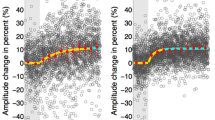Abstract
Saccades were elicited in 30 schizophrenic patients before medication, in 17 of them during medication with neuroleptics, and in 12 healthy controls using six paradigms that tested different types of saccades: (a) the externally triggered and visually guided saccades; (b) the externally triggered and internally guided saccades (anti-saccades); and (c) the internally triggered and internally guided saccades (memory-guided saccades). Latency of the primary saccade, gain (eye amplitude to target amplitude), and percentage of unwanted saccades (fixation suppression errors) were calculated. The externally triggered and externally guided saccades were only slightly affected in the patients, indicating that the function of parieto-tectal pathways was preserved. In contrast, the internally guided and externally triggered saccades showed abnormally long latencies, slightly smaller gains, and an increased rate of suppression errors regardless of the medication status. These findings were even more pronounced in the internally triggered and internally guided saccades such as memory-guided saccades. According to animal experiments and studies on patients with disorders of the basal ganglia, the performance of these saccades is based on the function of the pre- and dorsolateral frontal cortex and its connections to the basal ganglia. The minimal improvement of some of the parameters after clinical improvement and during treatment with neuroleptics suggests that the eye-movement deficits are associated with abnormalities of schizophrenia, which do not basically change under medication with neuroleptics. The observed effects of neuroleptics also argue against a primary abnormality in the dopaminergic input to the frontal cortex – basal ganglia oculomotor loop and support the view that there is a primary disturbance of the cortical input to the oculomotor loop through the basal ganglia in schizophrenics.
Similar content being viewed by others
Author information
Authors and Affiliations
Additional information
Received: 20 December 1997 / Accepted: 15 September 1998
Rights and permissions
About this article
Cite this article
Müller, N., Riedel, M., Eggert, T. et al. Internally and externally guided voluntary saccades in unmedicated and medicated schizophrenic patients. Part II. Saccadic latency, gain, and fixation suppression errors. European Archives of Psychiatry and Clinical Neurosciences 249, 7–14 (1999). https://doi.org/10.1007/s004060050059
Issue Date:
DOI: https://doi.org/10.1007/s004060050059



